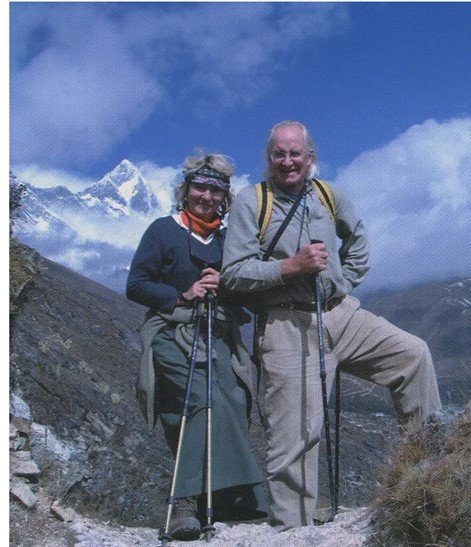Trekking For Good
Pic: Community Action Treks
Our long relationship with Doug Scott’s charity Community Action Nepal is well known, but did you know that you can help CAN’s great work by booking a trek with their sister company Community Action Treks?
Founded in the early 90’s by Doug, CAT offer bespoke treks throughout Nepal, as well as Bhutan, India and Tibet that are sustainable, ethical and give back to Himalayan communities. There is no greenwashing here – simply a continuation of Doug’s iron clad ethos of responsibility.
From the outset of his mountaineering career, Doug was fascinated by how people lived in the mountain environment. Deeply moved by the help he’d received from local people when injured in the mountains, (especially during his rescue from the Ogre) an opportunity to return help presented itself after an expedition to K2. Sadly, one of the expedition porters lost his life and Doug remained to complete the required paperwork during which time he was appalled by the high rate of infant mortality due to poor water supply to the Porters family village. His response was to secure £10,000 to bring clean water to Askole. Later, while in Nepal, an expedition porter named Tej asked Doug to help re-build the roof of the school in his village of Ghunsa, so he helped, and began 30 years of work to build CAN into the charity it is today.
Years of leading expeditions in Nepal had taught Doug about traditions, cultures, religions and corruption – vital skills for successfully communicating with local people. From the very beginning, Doug was very strict to ensure no CAN projects became western dependent. In the first instance they had to be requested by the local people themselves. He understood it was essential to get women’s groups onside and by using the Nepali concept of shramadan, where a percentage of the cost must be covered by the villagers, he encouraged local autonomy over projects to ensure longevity embedding local skills and community pride. This transformative ethos led to CAN setting a shining example of best practice and is today, recognised as one of the best run charities in Nepal.
Pic: Community Action Treks
In fact, CAN was one of the few charities allowed to work freely during Maoist occupation during the 10-year civil unrest, owing to their transparency and desire to equalise health and education outside of what was then, practically a City State of Kathmandu. This, along with a policy to treat army personnel and rebels alike (they had to be un-uniformed and un-armed), meant their health posts could continue to operate unhindered, although often proving extremely difficult for the brave CAN Nurses. Some facing warring groups trying to take them at gunpoint to “re-educate” them – all while the winter snows were laying 6 feet deep.
Projects are complete either when a road is built to them or when they are handed back to the government to be Nepali run.
So far, CAN has provided:
18 schools
In CAN schools, it is extremely important children are taught only in the Nepali medium and to a Nepali curriculum. Meals are offered to help improve concentration and cleanliness offers a sense of pride. Children are desperate to learn, and Mothers can work while the children are at school. The long-term downside of this is they’re educated and leave leading to a current question guiding CAN: Education improves individuals but how can it improve communities?
19 health posts
Health posts offer primary care through Western medicine alongside traditional Tibetan practices, preventative care, and treatment for the psychological effects of natural disasters.
3 porter shelters
Working in collaboration with the International Porter Protection Group these shelters provide medical care and education during peak trekking seasons. The porter shelter at Gorak Shep – built by local people it is likely the highest building in the world.
1 Sherpa heritage house
Including an elderly person’s complex
11 livelihood programmes
2000 villagers are now able to grow vegetables in 237 polytunnels creating 200 organic kitchen gardens across 4 Nepali provinces.
10 water supply projects
Pic: Community Action Treks
Since Doug’s sad passing in 2020, his wife Trish, moved to frontstage, pushing CAN’s work forward as Doug would have wished. She has a long experience of working in Nepal, helping to train Surgeons (In 1987 the Nepalese population was 18 million with only 15 surgeons.) Her inspiration to Doug, has been key including taking him to Hospices-de-Beaune in Burgundy, France where in the 15th Century, Nicolas Rolin gifted land to grow food and vineyards to pay for the hospital. Doug immediately transferred this vision to the CAN health posts, installing polytunnels and training nurses to advise on kitchen gardening – introducing green vegetables into the diet and creating a source of income.
Her proudest achievement for CAN is Bharabise– a school for deaf children which has now been handed over to the government and in Melamchigaon village, home of a top rural international school where the headmaster requested hostels to be built so the children did not have to walk 4 hours every day to attend school. CAN built the hostels navigating cultural jealousies while lifting the whole area economically.
None of this could happen, of course, without the Nepali CAN team based in Kathmandu – the bedrock of the charity.
So, if you are planning a trip with a difference; a trip that supports the people whose livelihoods depend on the vulnerable, breathtakingly beautiful regions of the world then click through to Community Action Treks website to see what they offer.
CAT’s objectives are simple:
· Provide an unforgettable experience for our customers
· Ensure fair treatment for supporting staff and trekking crews
· Put something back into the regions through which they operate (a proportion of profits are used to strengthen the work of the charity, Community Action Nepal)
Pic: Community Action Treks





